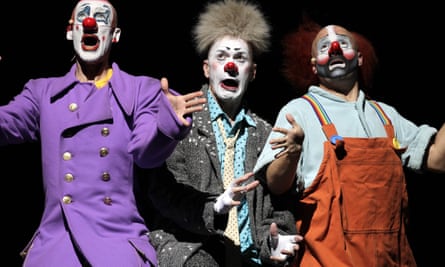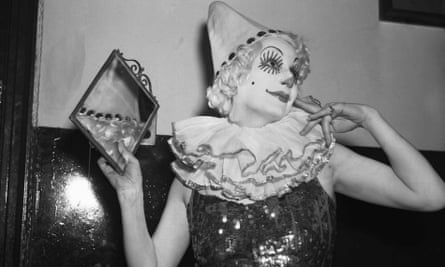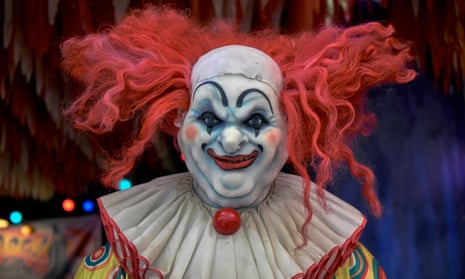“Send in the clowns. Don’t bother, they’re here,” goes the Stephen Sondheim song.
And now hysteria over creepy clown sightings has been rising to fever pitch in the US since August and is spreading internationally.
But the situation is so absurd that police departments are pleading with the attention-seekers to stop dressing up as evil clowns to scare people, while a woman organized a “peace march” that had been scheduled for Saturday night in support of clowns.
However it turned out that she herself wears some pretty scary clown makeup and had decided to call the event Clown Lives Matter.
When that crass echo of the protest movement over police killing unarmed black men triggered an avalanche of protest on social media and personal attacks against the organizer, who identifies herself on Facebook as Nikki Sinn, abruptly canceled the event. Sinn had at first declared herself amused.
“Lol, literally being called homophobic and racist for using ‘lives matter’….Haha wooow,” she posted on the social network, beneath a picture of herself grotesquely smiling with green hair and smudged eye make-up, seemingly as a version of Batman’s lethal nemesis, Joker.
That was followed by a further post on Thursday after she had canceled the event, reportedly because of threats, saying: “Kiss my ass ... I’ll march alone.”

Professional clowns are decidedly unamused.
“It’s not appropriate,” said Dick Milhollan, the last director of the former Ringling Brothers and Barnum & Bailey Clown College, which was based in Florida and closed in 1997, and half of the veteran clown duo Slappy and Monday.
This article includes content provided by Facebook. We ask for your permission before anything is loaded, as they may be using cookies and other technologies. To view this content, click 'Allow and continue'.
“My livelihood could be affected by the latest bout of clown impersonators scaring people but that’s nothing on the scale of the painful struggles being protested by Black Lives Matter, someone being shot or disliked because of the color of their skin,” he said.
“Meanwhile, every amateur Bozo is going to come out and that’s going to be what America sees, reinforcing the stereotype that being a clown is just about a big wig and face paint.”
The term has been trending on social media and overall clown hysteria is refusing to go away.
“Clown Lives Matter? Oh my God. I really don’t know that’s a good idea,” said Lorenzo Pisoni, a dramatic actor who originally began performing as a clown when he was two years old , and has just completed a documentary, Circus Kid, about growing up in the ring.
The controversy even reached Ronald McDonald when McDonald’s announced it was giving the clown mascot a break until the wave of hysteria passes.
And while some schools are banning clown outfits from Halloween celebrations this year, costume shops are making a killing and demented clowns are likely to be out in full force during trick-or-treat rituals and parades this 31 October.
“We’re selling out. Right now we have no clown costumes, because of this whole clown thing that’s happening in the news. You’d better look online,” a cashier at a New York branch of Party City said on Wednesday.
People across the US are now, variously, being arrested with fright-wigs, red noses and weapons, filmed clinging to the back of a moving bus, perpetrating hoaxes, causing school lockdowns, scaring the daylights out of people and exporting the craze to, at least, Britain and Australia.
Milhollan, alias Dick Monday, is at first offended even at being asked about the hysteria, having been clowning for more than 40 years in a profession where slapstick and self-mockery belies a finely-honed art form.
“If I dress up as a nun and stand on a street corner with a knife, it would seem odd if nuns then had to come out and defend their profession,” he said.
But he acknowledges that in “the world of clowns”, there are many paradoxes.
“In history they have been very powerful, you think of the court jester speaking truth to the king, Shakespeare’s wise fools as key characters, the European tradition of masks, the era of silent movies,” he said.
From Shakespeare’s Puck, King Lear’s Fool and the riddling gravediggers in Hamlet, uncovering the skull of the jester, Yorick, to Charlie Chaplin and Buster Keaton, today’s top clowns are steeped in a proud but enigmatic tradition.
American circuses emerged in the 18th century and the traveling circus took off in the 19th century, performing in gigantic arenas, where clowns exaggerated their outfits and makeup to help audiences follow their comedic expressions and gestures more easily, Milhollan explained.
The 50th Smithsonian Folklife Festival will pay tribute to clowning and other circus acts in 2017 with exhibitions on the National Mall in Washington.
“Since President George Washington attended John Bill Ricketts’ circus in Philadelphia in 1793, circus arts have intrigued generations,” the festival website states.

Multi-talented clown Dan Rice became a household name in America in the mid-1800s, with his performing pig, Sybil. He ran for president – unsuccessfully, obviously – but coined the popular phrase “jump on the bandwagon” after inviting future president Zachary Taylor onto his traveling circus cart. Legend has it Rice even inspired Uncle Sam’s aesthetic .
But the traveling circus in both Europe and the US always had its vagabond side with performers, circus hands and animals crammed into wagons, side-shows drawing pick-pockets and brawlers, life on the road attracting runaways and, no doubt, the odd fugitive.
“Shaking that stigma isn’t easy,” said Milhollan.
His clowning partner and wife Tiffany Riley, alias Slappy, said that clowning is a much misunderstood art form.
“Being ridiculous is a serious business,” she said. Slappy graduated from New York University’s Tisch School of the Arts and she and Monday toured with the Big Apple Circus.
They’ve trained clowns and straight actors and now are often employed to perform in schools or cheer up children in hospitals, where the kids call her Dr Slappy. She’s currently writing her master’s thesis on the effects of humor on healing.
“It upsets me, it really hurts,” she said of the new wave of clown hysteria and hopes it will die down after Halloween. “But some people are drawn to the dark side of everything and if you put the make-up on a certain way, it’s scary, I’ll grant you that”.
Vocational clowns are not only up against amateurs and imposters – a new film version of Stephen King’s horror novel It is underway, with an evil clown who preys on children as well as everyone’s phobias and fears.
And TV’s American Horror Story series has twice recently invoked the real life serial killer John Wayne Gacy, a former clown who murdered at least 33 males in Illinois in the 1970s.
“Distrust of clowns is deeply entrenched. The make-up that can be un-nerving and the archetype of the jester operating outside the normal rules of society – if you take that one step further you can draw that character as a killer and then you’re off to the races, a figure that is adored and revered is co-opted and professional clowns have to reassure people and separate themselves from the crazy people running around. It’s exasperating,” said Pisoni.
But he also acknowledges that “there is an inherent distrust of someone who is always smiling”.
But while scary pretend clowns hide behind their garb to threaten people, Pisoni said professional clowns flip that on its head – they are vulnerable, baring their souls as they attempt the tricky art of making an audience laugh.
His new documentary, Circus Kid, which screened at the Woodstock Film Festival on Friday and is showing at DOC NYC in New York on Monday, is based on his biographical play Humor Abuse, charting the trials and tribulations of growing up in the circus.
Pisoni began clowning principally to get the attention of his distracted father, clown Larry Pisoni, who created the Pickle Family Circus in California in 1974.
He describes how, beneath the costume, the gags and the acrobatics, his father was a depressive who dealt poorly with his mental “demons” and had a nervous breakdown in 1987.
As that famous Smokey Robinson lyric goes: “Ain’t too much sadder than the tears of a clown.”
Lorenzo Pisoni fled the circus once when he reached adulthood and became a dramatic stage and screen actor. Performing drama is a lot easier than comedy, he pointed out.
And he’ll be distancing himself a long way from Clown Lives Matter.
“It’s making a lot out of something that’s not funny,” he said.

Comments (…)
Sign in or create your Guardian account to join the discussion